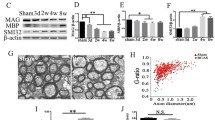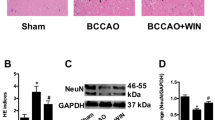Abstract
One of common pathophysiological states associated with central nervous system is chronic cerebral hypoperfusion (CH) that frequently occurs in conditions such as vascular dementia and Alzheimer’s disease. Long term blockage of angiotensin II type 1 (AT1) receptor provides protection from ischemia induced injury of brain as well as reduction of cerebrovascular inflammation. Examining effect of the blockage on reduced glutathione (GSH), ascorbic acid (AA), and lipid peroxidation were of purpose in the present study. Modeling CH, rats were subjected to permanent occlusion of common carotid arteries bilaterally. AT1 receptor antagonist, candesartan, was given daily for 14 days after surgery. CH caused a significant increase in lipid peroxidation and decrease in GSH content of cerebral hippocampal tissue with no change in AA level. Candesartan (0.5 mg/kg, oral) not only reduced lipid peroxidation but also restored GSH significantly besides elevating AA and improving histopathological alterations. In conclusion, long term AT1 receptor blockage may be considered as novel therapeutic approach for protection from damage associated with CH. Underlying mechanism(s) may in part be related to suppressing oxidative stress and preserving brain antioxidant capacity.



Similar content being viewed by others
References
Farkas E, Institoris A, Domoki F et al (2006) The effect of pre and posttreatment with diazoxide on the early phase of chronic cerebral hypoperfusion in the rat. Brain Res 1087:168–174
Liu HX, Zhang JJ, Zheng P et al (2005) Altered expression of MAP-2, GAP-43, and synaptophysin in the hippocampus of rats with chronic cerebral hypoperfusion correlates with cognitive impairment. Mol Brain Res 139:169–177
Wang LM, Han YF, Tang XC (2000) Huperzine A improves cognitive deficits caused by chronic cerebral hypoperfusion in rats. Eur J Pharmacol 398:65–72
Kasparova S, Brezova V, Valko M et al (2005) Study of the oxidative stress in a rat model of chronic brain hypoperfusion. Neurochem Int 46:601–611
Tanaka K, Wada N, Ogawa N (2000) Chronic cerebral hypoperfusion induces transient reversible monoaminergic changes in the rat brain. Neurochem Res 25:313–320
Aliev G, Smith MA, Obrenovich ME et al (2003) Role of vascular hypoperfusion-induced oxidative stress and mitochondria failure in the pathogenesis of Alzheimer’s disease. Neurotox Res 5:491–504
De Jong GI, Farkas E, Stienstra CM et al (1999) Cerebral hypoperfusion yields capillary damage in the hippocampal CA1 area that correlates with spatial memory impairment. Neuroscience 91:203–210
Kume-Kick J, Rice ME (1998) Estrogen-dependent modulation of rat brain ascorbate levels and ischemia-induced ascorbate loss. Brain Res 803:105–113
Zhou J, Ando H, Macova M et al (2005) Angiotensin II AT1 receptor blockade abolishes brain microvascular inflammation and heat shock protein responses in hypertensive rats. J Cereb Blood Flow Metab 25:878–886
Mack WJ, Mocco J, Ducruet AF et al (2006) A cerebroprotective dose of intravenous citrate/sorbitol-stabilized dehydroascorbic acid is correlated with increased cerebral ascorbic acid and inhibited lipid peroxidation after murine reperfused stroke. Neurosurgery 59:383–388
De la Torre JC, Aliev G (2005) Inhibition of vascular nitric oxide after rat chronic brain hypoperfusion: Spatial memory and immunohistochemical changes. J Cereb Blood Flow Metab 25:663–672
Cho KO, La HO, Cho YJ et al (2006) Minocycline attenuates white matter damage in a rat model of chronic cerebral hypoperfusion. J Neurosci Res 83:285–291
Lee JH, Park SY, Shin YW et al (2006) Neuroprotection by cilostazol, a phosphodiesterase type 3 inhibitor, against apoptotic white matter changes in rat after chronic cerebral hypoperfusion. Brain Res 1082:182–191
Tanaka K, Hori K, Wada-Tanaka N et al (2001) FK506 ameliorates the discrimination learning impairment due to preventing the rarefaction of white matter induced by chronic cerebral hypoperfusion in rats. Brain Res 906:184–189
Wakita H, Tomimoto H, Akiguchi I et al (2003) Ibudilast, a phosphodiesterase inhibitor, protects against white matter damage under chronic cerebral hypoperfusion in the rat. Brain Res 992:53–59
Collino M, Aragno M, Mastrocola R et al (2006) Modulation of the oxidative stress and inflammatory response PPAR-gamma agonists in the hippocampus of rats exposed to cerebral ischemia/reperfusion. Eur J Pharmacol 530:70–80
Gard PR (2004) Angiotensin as a target for the treatment of Alzheimer’s disease, anxiety and depression. Expert Opin Ther Targets 8:7–14
Forder JP, Munzenmaier DH, Grene AS (2005) Angiogenic protection from focal ischemia with angiotensin II type 1 receptor blockade in the rat. Am J Physiol Heart Circ Physiol 288:H1989–H1996
Hosomi N, Nishiyama A, Ban CR et al (2005) Angiotensin type 1 receptor blockage improves ischemic injury following transient focal cerebral ischemia. Neuroscience 134:225–231
Kusaka I, Kusaka G, Zhou C et al (2004) Role of AT1 receptors and NAD(P)H oxidase in diabetes-aggravated ischemic brain injury. Am J Physiol Heart Circ Physiol 286:H2442–H2451
Ando H, Zhou J, Mocavo M et al (2004) Angiotensin II AT1 receptor blockade reverses pathological hypertrophy and inflammation in brain microvessels of spontaneously hypertensive rats. Stroke 35:1726–1731
Engelhorn T, Goerike S, Doerfler A et al (2004) The angiotensin II type 1-receptor blocker candesartan increases cerebral blood flow, reduces infarct size, and improves neurologic outcome after transient cerebral ischemia in rats. J Cereb Blood Flow Metab 24:467–474
Takagi T, Yoshida N, Isozaki Y et al (2006) CV-11974, angiotensin II type 1 receptor antagonist, protects against ischemia-reperfusion injury of the small intestine in rats. Eur J Pharmacol 535:283–290
Araya J, Tsuruma T, Hirata K et al (2002) TCV-116, an angiotensin II type 1 receptor antagonist, reduces hepatic ischemia–reperfusion injury in rats. Transplantation 73:529–534
Casini AF, Ferrali M, Pompella A et al (1986) Lipid peroxidation and cellular damage in extrahepatic tissues of bromobenzene-intoxicated mice. Am J Pathol 123:520–531
Aykac G, Uysal M, Yalan AS et al (1985) The effects of chronic ethanol injection on hepatic lipid peroxide, glutathione, glutathione peroxidase and glutathione transferase in rats. Toxicology 36:71–76
Berger J, Shepard D, Morrow F et al (1989) Relationship between dietary intake and tissue levels of reduced and total vitamin C in the nonscorbutic guinea pig. J Nutr 119:734–740
Behl C, Moosmann B (2002) Antioxidant neuroprotection in Alzheimer’s disease as preventive and therapeutic approach. Free Radic Biol Med 33:182–191
Sugawara T, Kinouchi H, Oda M et al (2005) Candesartan reduces superoxide production after global cerebral ischemia. Neuroreport 16:325–328
De la Torre JC, Pappas BA, Prevot V et al (2003) Hippocampal nitric oxide upregulation precedes memory loss and A beta 1–40 accumulation after chronic brain hypoperfusion in rats. Neurol Res 25:635–641
Butterfield DA, Castegna A, Lauderback CM et al (2002) Evidence that amyloid beta-peptide-induced lipid peroxidation and its sequelae in Alzheimer’s disease brain contribute to neuronal death. Neurobiol Aging 23:655–664
Lu Q, Zhu YZ, Wong PT (2005) Neuroprotective effects of candesartan against cerebral ischemia in spontaneously hypertensive rats. Neuroreport 16:1963–1967
Saavedra JM (2005) Brain Angiotensin II: New developments, unanswered questions and therapeutic opportunities. Cell Mol Neurobiol 25:485–512
Engelhorn T, Doerfler A, Heusch G et al (2006) Reduction of cerebral infarct size by the AT1-receptor blocker candesartan, the HMG-CoA reductase inhibitor rosuvastatin and their combination An experimental study in rats. Neurosci Lett 406:92–96
Ness AR, Powles JW, Khaw KT (1996) Vitamin C and cardiovascular disease: a systematic review. J Cardiovasc Res 3:513–521
Dringen R, Gutterer JM, Hirrlinger J (2000) Glutathione metabolism in brain metabolic interaction between astrocytes and neurons in the defense against reactive oxygen species. Eur J Biochem 267:4912–4916
Ozacmak VH, Sayan H, Arslan SO et al (2005) Protective effect of melatonin on contractile activity and oxidative injury induced by ischemia and reperfusion of rat ileum. Life Sci 76:1575–1588
Cooper AJ, Kristal BS (1997) Multiple roles of glutathione in the central nervous system. Biol Chem 378:793–802
Hall A (1999) The role of glutathione in the regulation of apoptosis. Eur J Clin Invest 29:238–245
Tanaka K, Wada-Tanaka N, Miyazaki I et al (2002) Chronic cerebral hypoperfusion induces striatal alterations due to the transient increase of NO production and the depression of glutathione content. Neurochem Res 27:331–336
Savaksan E, Hock C, Olivieri G et al (2001) Cortical alterations of angiotensin converting enzyme, angiotensin II and AT1 receptor in Alzheimer’s dementia. Neurobiol Aging 22:541–546
Author information
Authors and Affiliations
Corresponding author
Rights and permissions
About this article
Cite this article
Ozacmak, V.H., Sayan, H., Cetin, A. et al. AT1 Receptor Blocker Candesartan-induced Attenuation of Brain Injury of Rats Subjected to Chronic Cerebral Hypoperfusion. Neurochem Res 32, 1314–1321 (2007). https://doi.org/10.1007/s11064-007-9305-1
Received:
Accepted:
Published:
Issue Date:
DOI: https://doi.org/10.1007/s11064-007-9305-1




